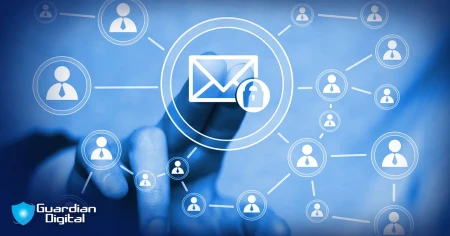Protecting Your Organization from Email Spoofing: The Power of DMARC Validation
- by Brittany Day

Email communication is crucial in business operations, and ensuring its security and authenticity is paramount. DMARC (Domain-based Message Authentication, Reporting, and Conformance) validation is essential for email administrators to combat email spoofing and phishing attacks.
However, despite its benefits, many administrators need assistance and guidance when implementing DMARC validation. This article will explore common DMARC validation issues and provide troubleshooting tips to help email administrators effectively address them.
What Are Common DMARC Validation Issues & Challenges?
Common DMARC validation issues admins encounter include:
Misconfigured DNS Records
DMARC validation relies on DNS records, specifically the DMARC record, to authenticate emails. One common issue is the misconfiguration of these DNS records, leading to failed DMARC validation. To troubleshoot this issue, it is crucial to understand the correct configuration of DMARC records and follow a step-by-step guide to set them up correctly. Additionally, various tools are available to verify the correctness of DNS record configuration.
Unaligned DKIM or SPF Identifiers
Another common issue arises when the DKIM (DomainKeys Identified Mail) or SPF (Sender Policy Framework) identifiers are not aligned with DMARC policies. DKIM and SPF are authentication mechanisms to prevent email forgery, and DMARC relies on their alignment for successful validation. Troubleshooting unaligned identifiers involves understanding the concept of alignment and implementing techniques to ensure their alignment with DMARC policies.
Inconsistent Reporting Data
DMARC generates aggregate and forensic reports that provide valuable insights into email authentication failures and potential threats. However, these reports may sometimes show inconsistent or incomplete data, making identifying and resolving issues challenging. Addressing inconsistent reporting data requires using dedicated tools to accurately analyze and interpret the reports. Furthermore, taking the necessary steps to correct any discrepancies found is crucial to maintaining a robust DMARC validation system.
How Can I Troubleshoot Misconfigured DNS Records?
DMARC validation heavily relies on correctly configured DNS records. To troubleshoot misconfigured records, administrators should understand the structure and purpose of DMARC DNS records. It is advisable to follow a step-by-step guide provided by a trusted source to ensure proper configuration. In addition, helpful online tools are available to verify the correctness and completeness of DNS record settings.
How Can I Address Unaligned DKIM or SPF Identifiers?
DKIM and SPF authentication mechanisms are crucial components of DMARC validation. When DKIM or SPF identifiers are not aligned with DMARC policies, emails may fail DMARC validation. Troubleshooting this issue requires understanding the concept of alignment and implementing techniques to align the identifiers correctly. It involves updating DKIM signatures and SPF records to match the policies defined in the DMARC record. Additionally, verifying the alignment using DMARC analyzers can help ensure proper configuration.
How Can I Resolve Inconsistent Reporting Data?
DMARC generates aggregate and forensic reports that provide valuable insights into email authentication failures and potential threats. However, these reports may sometimes need more consistent or complete data, making it challenging for administrators to identify and resolve issues. Administrators should utilize specialized tools to analyze DMARC reports accurately to address this. These tools can help identify discrepancies, pinpoint authentication failures, and take appropriate corrective actions to maintain a robust DMARC validation system.
DMARC Validation Best Practices for Admins
While troubleshooting common issues is crucial, implementing best practices is equally essential for maintaining an effective DMARC validation system. Regular monitoring and maintenance, including analyzing DMARC reports, should be performed to identify anomalies or patterns. Based on these findings, making timely changes and updates to alignment configurations can help prevent future issues. Furthermore, providing training and education to email administrators on DMARC implementation and maintenance can help ensure better comprehension and proactive measures.
Keep Learning About Preventing Email Spoofing Attacks
DMARC validation is an indispensable tool for email administrators to combat email spoofing and phishing attacks. However, implementation may lead admins to encounter misconfigured DNS records, unaligned DKIM or SPF identifiers, and inconsistent reporting data. Administrators can effectively address these challenges by understanding these issues and following the troubleshooting tips provided. Maintaining a well-configured DMARC system and engaging in best practices will enhance email security and protect an organization and its stakeholders from potential email threats. Implementing DMARC validation is essential to creating a safer and more trustworthy email environment.
Continue learning about securing the inbox against spoofing and impersonation attacks by exploring the resources below:
- Learn about business impersonation attacks and how to stop them.
- Learn how impersonation attacks target CEOs via email.
- Get the latest updates on how to stay safe online.
Must Read Blog Posts
- Demystifying Phishing Attacks: How to Protect Yourself in 2025
- Must Read - How Phishing Emails Bypass Microsoft 365 Default Security
- Must Read - Shortcomings of Endpoint Security in Securing Business Email
- Must Read - What You Need to Know to Shield Your Business from Ransomware
- Must Read - Email Virus: Complete Guide to Email Viruses & Best Practices
- Must Read - Microsoft 365 Email Security Limitations You Should Know in 2025
Latest Blog Articles
- 8 Enterprise Email Security Best Practices to Prevent Cyberattacks
- Understanding the Importance of Data Security in HRIS
- The Hidden Risk: Leaked Employee Emails
- Giovanni Bechis' Bold Plans to Transform SpamAssassin
- Proven Ransomware Detection Techniques For Improved Security
- Boost Your Network Security with These Proven Techniques
- A Guide to Email Security: Training to Keep Your Team and Business Secure
- Enhancing Email Security: The Role of Unified Observability in Microsoft 365
- The Cloud Advantage: Boosting Your Business Email Security
- Mastering Multi-Factor Authentication (MFA): A Step-by-Step Guide for IT and Security Admins